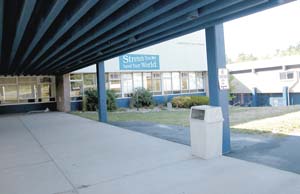
|
Democrat File Photo
THE SCHOOL MOTTO, at Monticello High School, displayed in the inner courtyard at Monticello High School, is “Stretch Your Mind, Expand Your World.”
|
Superintendent: Monticello High School Is Not A Dropout Factory
By Jeanne Sager
MONTICELLO — December 21, 2007 — So Johns Hopkins University is calling Monticello a “dropout factory.” Where’s the news in that?
Monticello Central School Superintendent Dr. Pat Michel almost snorted when he heard the declaration from the Maryland university best known for its medical college.
“We’ve never hidden the fact that our dropout rate is high,” Michel said.
That’s one of the driving factors behind a district-wide refocusing on student achievement.
But Michel wasn’t taking the criticism lying down.
“It’s easy for the wealthy, aristocratic people at Johns Hopkins to criticize the job we’re doing here, but I’d challenge them to do it,” he said.
Officially, the term “dropout factory” came from a Johns Hopkins study, commissioned by the Associated Press (AP), which fingered 15 upstate New York high schools for dropping the ball.
In all, New York State had 110 schools that met the researchers’ criteria, including Ellenville High School in nearby Ulster County.
Using state education department data from 2004 through 06, researchers zeroed in on schools in which less than 60 percent of the students who entered the high school as freshman were members of the senior class.
Robert Balfanz, the researcher who coined the term “dropout factory,” told the AP that meant at least 40 percent of the class was lost along the way – usually because they dropped out of school.
Data was reviewed over a three-year period, the report states, to ensure local events, like a major layoff, did not factor into the dip in student attendance.
But Michel easily poked holes in the report.
“This study uses what is called a cohort model,” he explained – a model that compares the number of freshman to the number of students who graduate.
“New York State does not use this model for several reasons,” Michel continued.
“Most schools count more than just the students entering the ninth grade as freshmen,” he explained. “What that means is that if a student fails three or more classes, they are considered freshmen year to year.
“In our case, our freshmen class, until last year, was 50 students larger then the entering ninth grade class,” Michel said.
Ask Michel why Monticello has a problem with dropouts, and he gives you a quick answer.
“It’s called poverty,” he said.
Families move, often, which disrupts children’s lives – reducing their chances of academic success.
It also means they’re often transferring out of the district in the middle of their high school careers.
“When you are in a district like ours with such a high poverty rate it is like having a factory closing very day,” Michel said. “What I mean by that is that the population is very transient.
“People leave the district and return three or four times and then leave for good,” Michel said. “We have what we call the poverty triangle – when a family is evicted in Monticello, they move to Fallsburg, and when they get evicted from Fallsburg, they move to Liberty.
“We see this pattern again and again,” he said. “By June we see those same students return to Monticello. No wonder a child cannot succeed!”
The researchers focused their report on the poverty angle – including not just the percentage of students graduating, but the percentage who receive a free or reduced lunch as well as the percentage of minorities in the district.
Monticello had a 56 percent graduation rate, researchers said, and estimated 35.9 percent receive a free or reduced lunch.
Michel said the number’s much higher – he estimates 62 percent of the district’s students qualify for meals given to those coming from low-income families.
What Johns Hopkins never looked at, he said, is the unofficial report card from the state that states that the Robert J. Kaiser Middle School is no longer considered in need of improvement in mathematics.
It didn’t look at the New York State Education Department’s assessment that the district is doing OK, Michel said.
“We made [Adequate Yearly Progress] for graduation rate last year,” Michel said, referring to the designation the state education department gives to schools that have “made acceptable progress… toward the goal of proficiency for all students.”
“We believe that the dropout rate is a real problem and have gone through a huge reorganization process to address it,” Michel reiterated.
He credited former Superintendent Eileen Casey and former Assistant Superintendent Bob Falcone with laying a good groundwork for the progress made in the past two year tenure in administration (Michel has been superintendent for one year, but he was assistant to Casey before that).
“Do I think we’re well on our way? Absolutely,” Michel said. “Is it going to happen overnight? No.
“We’ve asked for five years, we’re two years in, and I think we’ve made a lot of progress,” he continued.
“I’m a little bit miffed that Johns Hopkins comes up with their own formula to measure our success,” he said. “I wonder what Johns Hopkins dropout rate is!”
|

